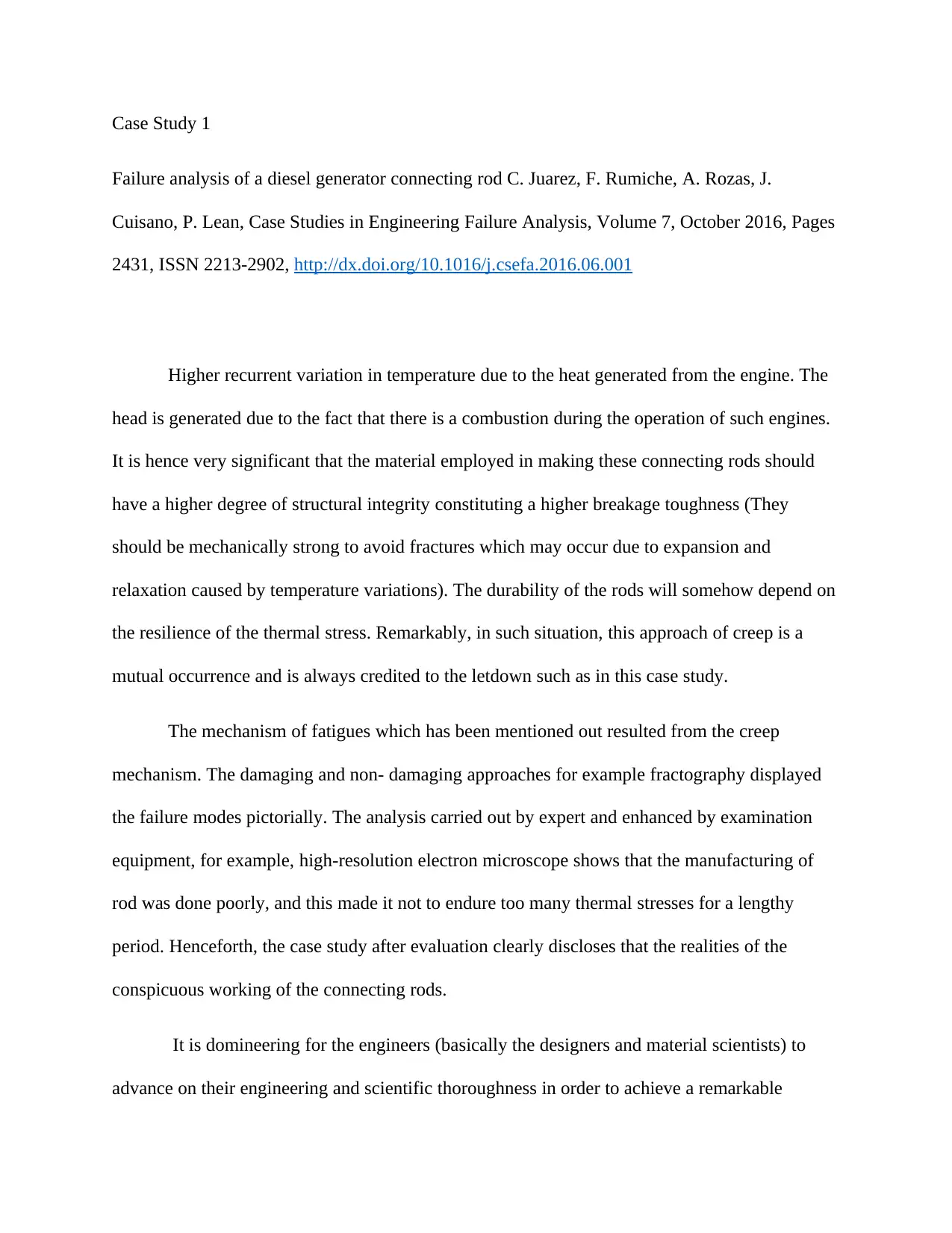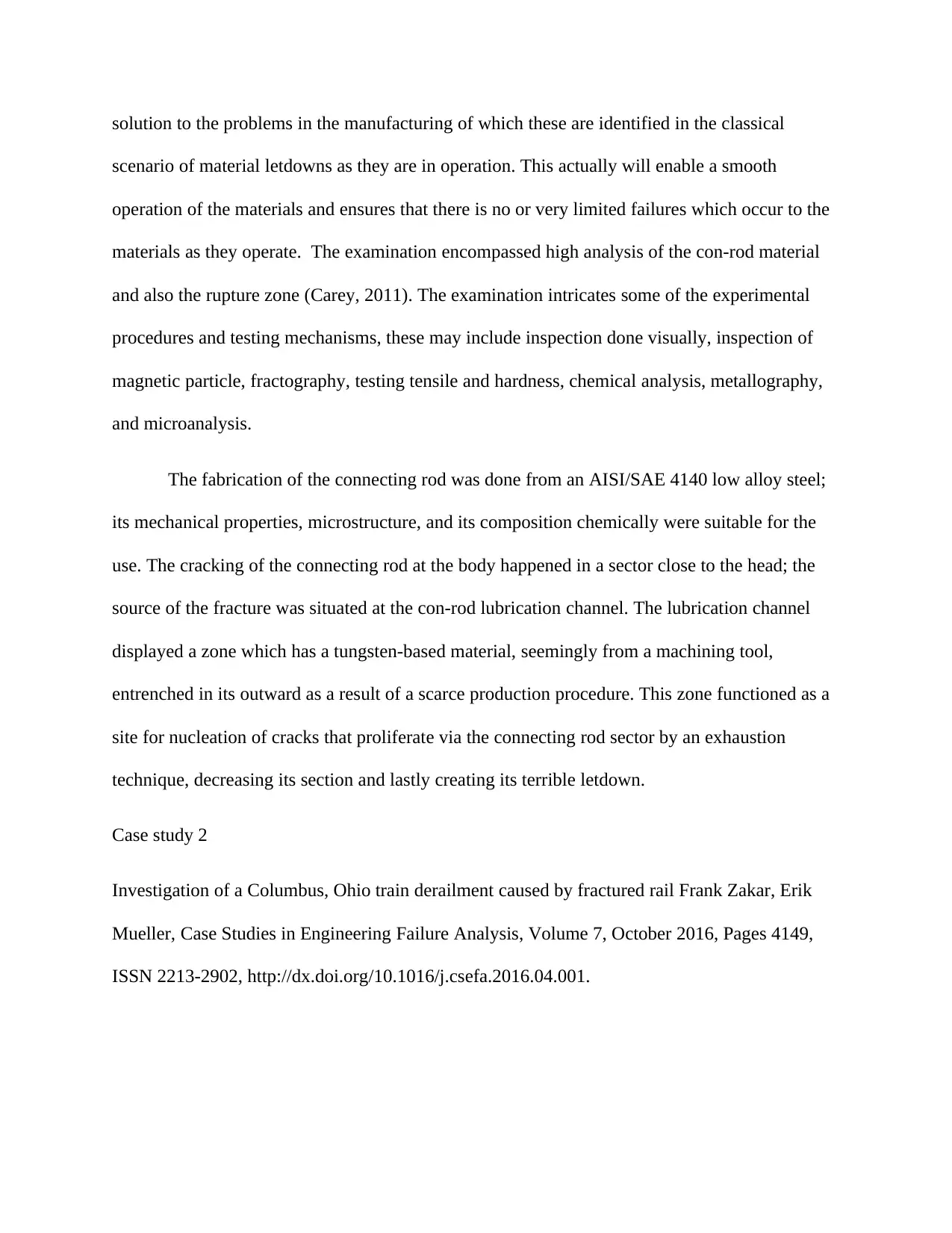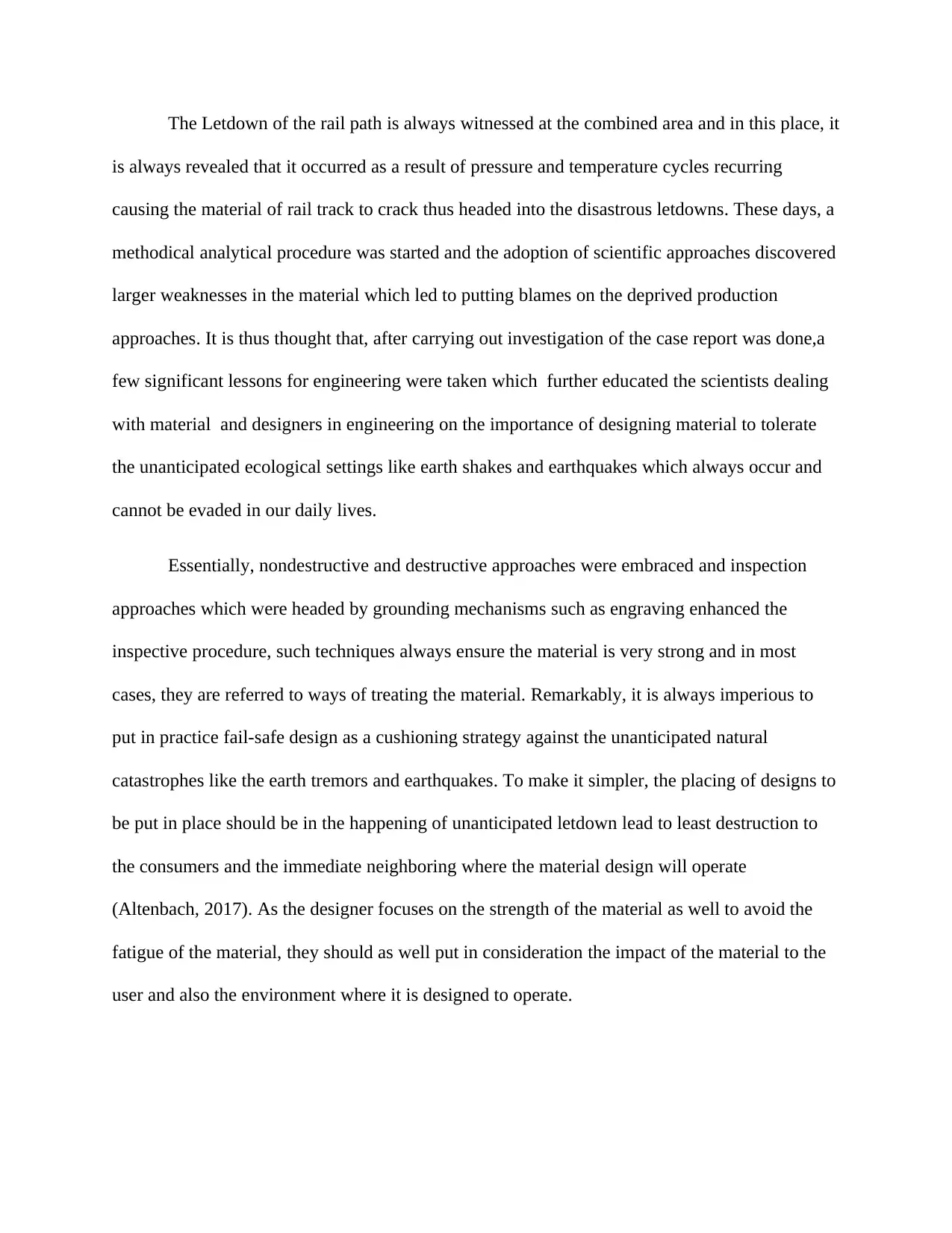MP4702 Advanced Materials and Selection: Failure Analysis Cases
VerifiedAdded on 2023/06/15
|5
|958
|383
Case Study
AI Summary
This assignment presents two case studies related to material failure analysis. The first case examines the failure of a diesel generator connecting rod, attributing it to high-temperature variations, poor manufacturing, and tungsten-based material inclusions acting as crack nucleation sites. The analysis involved visual inspection, magnetic particle inspection, fractography, tensile and hardness testing, chemical analysis, metallography, and microanalysis. The second case investigates a train derailment caused by a fractured rail, linking the failure to pressure and temperature cycles leading to cracks. The investigation emphasized the importance of robust design to withstand environmental factors and the implementation of fail-safe designs. Both cases underscore the need for thorough engineering practices and material selection to prevent failures. Desklib provides a platform for students to access similar solved assignments and past papers.

ADVANCE MATERIAL AND MATERIAL SELECTION
By Name
Course
Instructor
Institution
Location
Date
By Name
Course
Instructor
Institution
Location
Date
Paraphrase This Document
Need a fresh take? Get an instant paraphrase of this document with our AI Paraphraser

Case Study 1
Failure analysis of a diesel generator connecting rod C. Juarez, F. Rumiche, A. Rozas, J.
Cuisano, P. Lean, Case Studies in Engineering Failure Analysis, Volume 7, October 2016, Pages
2431, ISSN 2213-2902, http://dx.doi.org/10.1016/j.csefa.2016.06.001
Higher recurrent variation in temperature due to the heat generated from the engine. The
head is generated due to the fact that there is a combustion during the operation of such engines.
It is hence very significant that the material employed in making these connecting rods should
have a higher degree of structural integrity constituting a higher breakage toughness (They
should be mechanically strong to avoid fractures which may occur due to expansion and
relaxation caused by temperature variations). The durability of the rods will somehow depend on
the resilience of the thermal stress. Remarkably, in such situation, this approach of creep is a
mutual occurrence and is always credited to the letdown such as in this case study.
The mechanism of fatigues which has been mentioned out resulted from the creep
mechanism. The damaging and non- damaging approaches for example fractography displayed
the failure modes pictorially. The analysis carried out by expert and enhanced by examination
equipment, for example, high-resolution electron microscope shows that the manufacturing of
rod was done poorly, and this made it not to endure too many thermal stresses for a lengthy
period. Henceforth, the case study after evaluation clearly discloses that the realities of the
conspicuous working of the connecting rods.
It is domineering for the engineers (basically the designers and material scientists) to
advance on their engineering and scientific thoroughness in order to achieve a remarkable
Failure analysis of a diesel generator connecting rod C. Juarez, F. Rumiche, A. Rozas, J.
Cuisano, P. Lean, Case Studies in Engineering Failure Analysis, Volume 7, October 2016, Pages
2431, ISSN 2213-2902, http://dx.doi.org/10.1016/j.csefa.2016.06.001
Higher recurrent variation in temperature due to the heat generated from the engine. The
head is generated due to the fact that there is a combustion during the operation of such engines.
It is hence very significant that the material employed in making these connecting rods should
have a higher degree of structural integrity constituting a higher breakage toughness (They
should be mechanically strong to avoid fractures which may occur due to expansion and
relaxation caused by temperature variations). The durability of the rods will somehow depend on
the resilience of the thermal stress. Remarkably, in such situation, this approach of creep is a
mutual occurrence and is always credited to the letdown such as in this case study.
The mechanism of fatigues which has been mentioned out resulted from the creep
mechanism. The damaging and non- damaging approaches for example fractography displayed
the failure modes pictorially. The analysis carried out by expert and enhanced by examination
equipment, for example, high-resolution electron microscope shows that the manufacturing of
rod was done poorly, and this made it not to endure too many thermal stresses for a lengthy
period. Henceforth, the case study after evaluation clearly discloses that the realities of the
conspicuous working of the connecting rods.
It is domineering for the engineers (basically the designers and material scientists) to
advance on their engineering and scientific thoroughness in order to achieve a remarkable

solution to the problems in the manufacturing of which these are identified in the classical
scenario of material letdowns as they are in operation. This actually will enable a smooth
operation of the materials and ensures that there is no or very limited failures which occur to the
materials as they operate. The examination encompassed high analysis of the con-rod material
and also the rupture zone (Carey, 2011). The examination intricates some of the experimental
procedures and testing mechanisms, these may include inspection done visually, inspection of
magnetic particle, fractography, testing tensile and hardness, chemical analysis, metallography,
and microanalysis.
The fabrication of the connecting rod was done from an AISI/SAE 4140 low alloy steel;
its mechanical properties, microstructure, and its composition chemically were suitable for the
use. The cracking of the connecting rod at the body happened in a sector close to the head; the
source of the fracture was situated at the con-rod lubrication channel. The lubrication channel
displayed a zone which has a tungsten-based material, seemingly from a machining tool,
entrenched in its outward as a result of a scarce production procedure. This zone functioned as a
site for nucleation of cracks that proliferate via the connecting rod sector by an exhaustion
technique, decreasing its section and lastly creating its terrible letdown.
Case study 2
Investigation of a Columbus, Ohio train derailment caused by fractured rail Frank Zakar, Erik
Mueller, Case Studies in Engineering Failure Analysis, Volume 7, October 2016, Pages 4149,
ISSN 2213-2902, http://dx.doi.org/10.1016/j.csefa.2016.04.001.
scenario of material letdowns as they are in operation. This actually will enable a smooth
operation of the materials and ensures that there is no or very limited failures which occur to the
materials as they operate. The examination encompassed high analysis of the con-rod material
and also the rupture zone (Carey, 2011). The examination intricates some of the experimental
procedures and testing mechanisms, these may include inspection done visually, inspection of
magnetic particle, fractography, testing tensile and hardness, chemical analysis, metallography,
and microanalysis.
The fabrication of the connecting rod was done from an AISI/SAE 4140 low alloy steel;
its mechanical properties, microstructure, and its composition chemically were suitable for the
use. The cracking of the connecting rod at the body happened in a sector close to the head; the
source of the fracture was situated at the con-rod lubrication channel. The lubrication channel
displayed a zone which has a tungsten-based material, seemingly from a machining tool,
entrenched in its outward as a result of a scarce production procedure. This zone functioned as a
site for nucleation of cracks that proliferate via the connecting rod sector by an exhaustion
technique, decreasing its section and lastly creating its terrible letdown.
Case study 2
Investigation of a Columbus, Ohio train derailment caused by fractured rail Frank Zakar, Erik
Mueller, Case Studies in Engineering Failure Analysis, Volume 7, October 2016, Pages 4149,
ISSN 2213-2902, http://dx.doi.org/10.1016/j.csefa.2016.04.001.
⊘ This is a preview!⊘
Do you want full access?
Subscribe today to unlock all pages.

Trusted by 1+ million students worldwide

The Letdown of the rail path is always witnessed at the combined area and in this place, it
is always revealed that it occurred as a result of pressure and temperature cycles recurring
causing the material of rail track to crack thus headed into the disastrous letdowns. These days, a
methodical analytical procedure was started and the adoption of scientific approaches discovered
larger weaknesses in the material which led to putting blames on the deprived production
approaches. It is thus thought that, after carrying out investigation of the case report was done,a
few significant lessons for engineering were taken which further educated the scientists dealing
with material and designers in engineering on the importance of designing material to tolerate
the unanticipated ecological settings like earth shakes and earthquakes which always occur and
cannot be evaded in our daily lives.
Essentially, nondestructive and destructive approaches were embraced and inspection
approaches which were headed by grounding mechanisms such as engraving enhanced the
inspective procedure, such techniques always ensure the material is very strong and in most
cases, they are referred to ways of treating the material. Remarkably, it is always imperious to
put in practice fail-safe design as a cushioning strategy against the unanticipated natural
catastrophes like the earth tremors and earthquakes. To make it simpler, the placing of designs to
be put in place should be in the happening of unanticipated letdown lead to least destruction to
the consumers and the immediate neighboring where the material design will operate
(Altenbach, 2017). As the designer focuses on the strength of the material as well to avoid the
fatigue of the material, they should as well put in consideration the impact of the material to the
user and also the environment where it is designed to operate.
is always revealed that it occurred as a result of pressure and temperature cycles recurring
causing the material of rail track to crack thus headed into the disastrous letdowns. These days, a
methodical analytical procedure was started and the adoption of scientific approaches discovered
larger weaknesses in the material which led to putting blames on the deprived production
approaches. It is thus thought that, after carrying out investigation of the case report was done,a
few significant lessons for engineering were taken which further educated the scientists dealing
with material and designers in engineering on the importance of designing material to tolerate
the unanticipated ecological settings like earth shakes and earthquakes which always occur and
cannot be evaded in our daily lives.
Essentially, nondestructive and destructive approaches were embraced and inspection
approaches which were headed by grounding mechanisms such as engraving enhanced the
inspective procedure, such techniques always ensure the material is very strong and in most
cases, they are referred to ways of treating the material. Remarkably, it is always imperious to
put in practice fail-safe design as a cushioning strategy against the unanticipated natural
catastrophes like the earth tremors and earthquakes. To make it simpler, the placing of designs to
be put in place should be in the happening of unanticipated letdown lead to least destruction to
the consumers and the immediate neighboring where the material design will operate
(Altenbach, 2017). As the designer focuses on the strength of the material as well to avoid the
fatigue of the material, they should as well put in consideration the impact of the material to the
user and also the environment where it is designed to operate.
Paraphrase This Document
Need a fresh take? Get an instant paraphrase of this document with our AI Paraphraser

Bibliography
Altenbach, H., 2017. Modeling of Creep for Structural Analysis. 2nd ed. Stoke: Springer Science &
Business Media.
Carey, M., 2011. Home Maintenance For Dummies using paints. 2nd ed. Chicago: John Wiley & Sons.
Altenbach, H., 2017. Modeling of Creep for Structural Analysis. 2nd ed. Stoke: Springer Science &
Business Media.
Carey, M., 2011. Home Maintenance For Dummies using paints. 2nd ed. Chicago: John Wiley & Sons.
1 out of 5
Your All-in-One AI-Powered Toolkit for Academic Success.
+13062052269
info@desklib.com
Available 24*7 on WhatsApp / Email
![[object Object]](/_next/static/media/star-bottom.7253800d.svg)
Unlock your academic potential
Copyright © 2020–2025 A2Z Services. All Rights Reserved. Developed and managed by ZUCOL.

